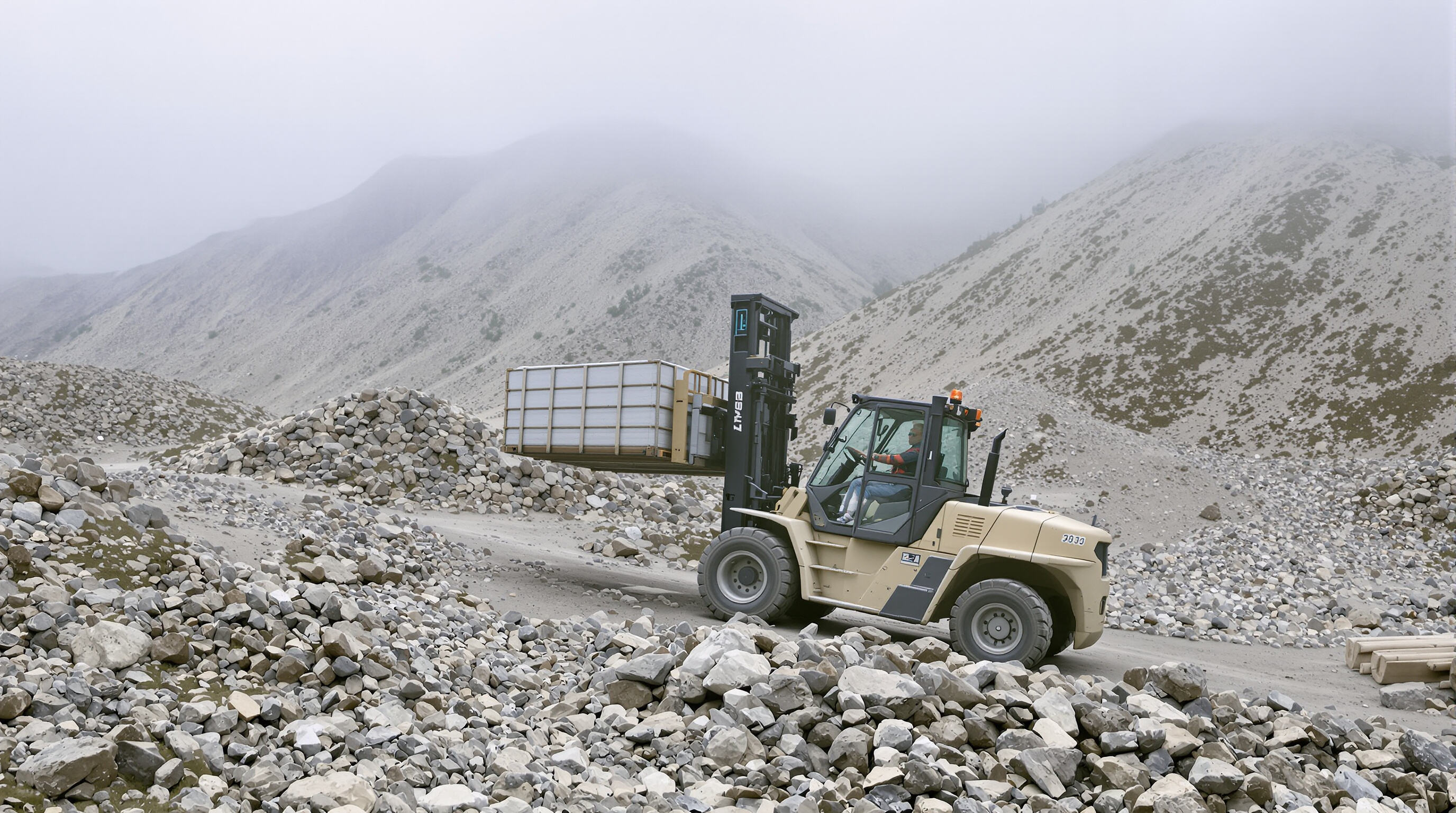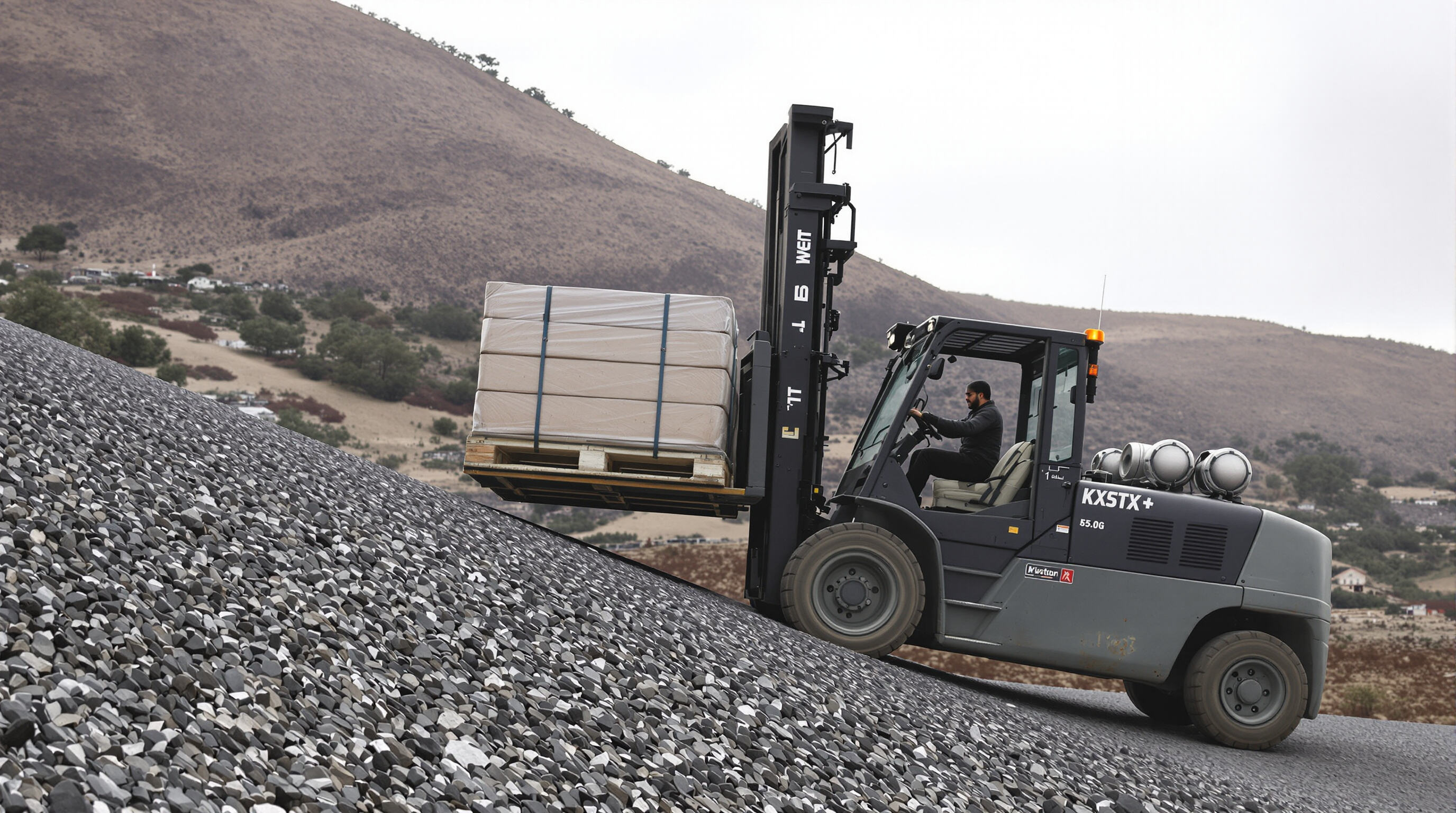Understanding All Terrain Forklifts and Their Role in Rugged Environments

What Sets All Terrain Forklifts Apart from Standard Models
All terrain forklifts were built specifically for those tough spots where regular forklifts just can't handle things. The big pneumatic tires grip much better on muddy ground or gravel roads compared to what most people see on normal warehouse floors. Plus they sit higher off the ground because of their reinforced frame, so they can roll right over small rocks and other stuff in the way. Most models come with four wheel drive plus some pretty good suspension that keeps them from tipping over even when going up hills or across rough patches. Because of these features, companies can actually move materials around places that would otherwise be impossible for standard equipment. Construction sites near forests or mining operations in mountainous regions rely heavily on these machines since nothing else works there.
Growing Demand Across Oil, Gas, Forestry, and Construction Sectors
The number of companies using all terrain forklifts around the world jumped nearly 27% after 2023, mainly because businesses needed reliable transport solutions for tough spots far from roads and paved surfaces. Oil fields rely on these machines to haul massive drilling parts through dirt and rocks where nothing else would work. Loggers find them indispensable too when moving timber through thick forests where regular trucks just get stuck. Mountain construction crews have seen something amazing happen too their material handling gets about 70-75% better when switching from traditional tracked vehicles to these versatile forklifts. What makes these machines so valuable is how they tackle rough landscapes without breaking down as often as other equipment does, saving time and money on repairs in places where getting spare parts can take days.
Real-World Application: Logistics in Mountainous and Remote Sites
In the rugged mining operations across the Andes mountains, all terrain forklifts play a vital role, navigating tight trails at around 4,100 meters elevation while moving heavy ore containers. These machines make it possible to position massive turbine parts on those steep mountain slopes at remote wind farm sites, where most roads barely exist beyond rough dirt tracks. After major earthquakes hit regions like Nepal or Chile, rescue crews bring these versatile machines into action to clear rubble from collapsed buildings when regular delivery trucks simply cannot reach affected areas. For projects located far from civilization, the reliability of these specialized forklifts often determines whether construction can proceed at all, since conventional transportation methods just won't work in such extreme environments.
Critical Features to Look for in an All Terrain Forklift
Durability and Build Quality for Extreme Conditions
Industrial all terrain forklifts need heavy duty steel frames to handle those massive loads, sometimes going all the way up to 30,000 pounds according to last year's Industrial Machinery Report. The frames are built tough with reinforced chassis and special materials that resist rust, so these machines can last years even when working in brutal environments such as construction sites or forests where things get pretty rough. Another key feature is their sealed hydraulic systems along with waterproof electrical parts. These design choices make them much more reliable when faced with mud, rain, or dust storms. Operators report about 42 percent less downtime than regular forklifts, which makes a big difference on job sites where every minute counts.
Engine Power and Fuel Options: Diesel, Propane, and Electric Compared
Diesel engines remain the top choice because they deliver strong torque, sometimes reaching around 130 horsepower, plus fuel is readily available even in remote locations where other options might fail. Propane burns cleaner so it works well in places like partially enclosed storage facilities, though drivers report about 15 percent shorter running time compared to diesel. Electric versions run silently and produce zero emissions, but most just don't have enough muscle to handle hills or rough terrain, which means they're mostly limited to flat spots such as packed gravel roads. The numbers back this up too: nearly three out of every four operators still go with diesel when tackling tough jobs outdoors, based on findings from the latest Fuel Efficiency Report released in 2024.
Ground Clearance and All-Terrain Tyre Systems for Maximum Traction
Getting at least 16 inches of ground clearance really helps protect the vehicle's undercarriage when driving over rocks or rough terrain. The aggressive tread pattern found on pneumatic tires makes a big difference in muddy or snowy conditions. These tires spread out weight over about 40 percent more surface area compared to regular cushion tires, which means they put roughly 28 percent less pressure on the ground beneath them according to that recent tire performance report from 2022. For steep hills, four wheel drive keeps things moving smoothly even on slopes as steep as 25 degrees. And those oscillating axles? They're pretty smart too, adjusting automatically to sudden changes in elevation so the load stays stable throughout the journey.
Evaluating Lift Capacity, Stability, and Performance on Inclines

How Load Capacity and Lift Height Are Impacted by Terrain
The rough terrain can cut down the actual lifting power by around 20 percent because of all the wobbling and extra friction between equipment and ground surface. The Industrial Safety Journal published this finding back in 2023 after looking at several warehouse operations. Take for example a standard forklift that handles 10,000 pounds on smooth concrete floors. When working on slopes with about 15 degrees angle, most operators would consider 8,000 pounds as the safe upper limit. What happens when it comes to lifting heights? Well, things get even trickier on bumpy surfaces. Many experienced drivers will cap their lifts at roughly 16 feet rather than going for full 20 feet capability just to keep everything stable and prevent accidents.
Managing Center of Gravity on Slopes and Uneven Ground
Stability on inclines depends on maintaining a low center of gravity through three key design features:
- Load positioning: Keeping loads 6–8 inches from the mast reduces tipping risk
- Counterweight design: Heavy-duty rear counterweights offset forces from uneven terrain
- Automatic tilt control: Advanced systems adjust mast angles up to 5° to stabilize loads on slopes
| Slope Angle | Safe Load Capacity | Recommended Speed Limit |
|---|---|---|
| 0–5° | 100% | 8 mph |
| 6–10° | 85% | 5 mph |
| 11–15° | 70% | 3 mph |
Avoiding Tip-Overs: Safety Engineering and Operator Best Practices
According to data from the National Forklift Safety Council released in 2022, forklift tip-over accidents decrease dramatically - around 62% actually - when workers receive proper certification along with machines equipped with stability tech. The real safety game changers? Checking slopes before operation with those little inclinometer devices, installing load sensors that automatically hit the brakes as weight approaches dangerous levels, and making sure hydraulic masts and tilt alarms get calibrated every three months or so. These regular checks keep everything running reliably day after day on busy warehouse floors.
Matching Tire Types and Mobility Features to Specific Terrain Challenges
Pneumatic vs. Cushion Tires: Which Is Right for Your Environment?
When it comes to outdoor performance, pneumatic tires really stand out because of their deep treads and strong sidewalls that help prevent punctures while keeping traction on uneven surfaces. These tires have a special tread pattern that actually pushes out mud and dirt as they roll along. Cushion tires just don't have this capability since they're designed primarily for flat indoor spaces like warehouses. According to some recent research published last year, pneumatic tires cut down on slippage by around forty percent when used in construction sites. This makes them especially valuable for all terrain forklifts working in places where the ground can be anything from muddy to rocky. Compared to those solid rubber options, pneumatic tires absorb shocks much better and keep things stable even when driving over bumps or loose gravel.
Performance on Muddy, Sandy, and Soft Surfaces
When driving through mud, tires with open tread patterns help keep sludge from collecting around the central part of the tire. Sand surfaces benefit from wider treads since they spread out the vehicle's weight better, while those paddle shaped lugs really dig into the ground for extra grip when moving forward. Vehicles stuck on soft terrain need balanced weight distribution across all wheels. Narrow tires can push down on the ground with up to 70% more pressure than wider ones according to field testing, which explains why machines often get stuck there. Getting the right tire specs for different surfaces isn't just about performance it actually saves time during operations when working in tough conditions where every minute counts.
Limitations of Cushion Tires in Outdoor and Rugged Applications
Outdoor cushion tires have several problems that limit their effectiveness. First off, they don't have much tread depth which leads to slipping when conditions get muddy or rocky. The tire walls are also pretty thin so they tend to get punctured easily by sharp objects like rocks and sticks. Plus, because of their stiff composition, these tires pass along a lot of vibration to whoever is operating equipment and whatever is being transported across rough ground. Because of all these issues, using cushion tires in places like forests, drilling sites, or mountain areas can actually be dangerous rather than just inconvenient.
A Step-by-Step Selection Guide for Choosing the Right All Terrain Forklift
Assessing Your Operational Needs and Site Conditions
When looking at a worksite, it's important to check several key aspects first. Think about how steep the slopes are, what kind of ground we're dealing with, how high obstacles might be, and what sort of loads will typically need transport. Forestry operations tell us something interesting here too. According to Industrial Equipment Journal from last year, around three out of every four equipment breakdowns happen because machines aren't properly matched to their load requirements on rough ground. For places where space is tight or conditions are unstable, like those tricky mining tunnels or muddy wetland areas, make sure to note down exactly what clearance and flexibility requirements exist. This helps when picking machinery that has enough power (torque) and can actually move around effectively in these challenging environments.
Terrain Suitability Checklist: Matching Machine to Environment
Use this checklist to align forklift features with site demands:
| Factor | Rugged Environment Requirement |
|---|---|
| Ground clearance | ≥12" for rock-strewn landscapes |
| Tire tread depth | 1.5"+ for muddy conditions |
| Slope handling | 15%+ grade capability with full load |
Testing hydraulic responsiveness in simulated conditions can yield significant savings—a quarry operator reduced fuel costs by 18% after switching to units with terrain-sensitive pressure regulation.
Balancing Cost, Performance, and Long-Term Reliability
All terrain forklifts that come at a premium price tag usually set back buyers around 20 to 35 percent extra compared to regular models. But these tougher machines tend to need repairs about 40 percent less often when put through harsh environments. When looking at what matters most for long term expenses, it pays to consider the full picture over roughly five years. For places far from power sources where charging just isn't feasible, Tier 4 diesel engines still make sense. However, where there are tight emission rules, going electric becomes the smarter choice. Maintenance schedules should match up with how busy operations actually run so that breakdowns don't happen right when things get hectic on site.
FAQ Section
What is the main advantage of all terrain forklifts?
All terrain forklifts are designed to operate in rugged environments where standard models fail, providing superior traction and durability in challenging terrains.
In which industries are all terrain forklifts commonly used?
They're heavily utilized in sectors like oil, gas, forestry, and construction, particularly in remote or rugged locations.
How do all terrain forklifts handle inclines and uneven ground?
These forklifts employ features like high ground clearance, four-wheel drive, and oscillating axles to maintain stability and traction on slopes and rough terrain.
Why are pneumatic tires preferred for outdoor use?
Pneumatic tires offer better traction, shock absorption, and puncture resistance, making them ideal for uneven and challenging outdoor environments.
How does terrain affect the lift capacity of forklifts?
Rough terrain can reduce lift capacity due to added friction and stability concerns, often requiring adjustments to safe load limits and lift heights.
Table of Contents
- Understanding All Terrain Forklifts and Their Role in Rugged Environments
- Critical Features to Look for in an All Terrain Forklift
- Evaluating Lift Capacity, Stability, and Performance on Inclines
- Matching Tire Types and Mobility Features to Specific Terrain Challenges
- A Step-by-Step Selection Guide for Choosing the Right All Terrain Forklift
- FAQ Section

